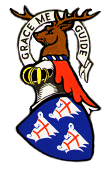 'Grace Me Guide'
'Grace Me Guide'

"Clan Forbes"
Exerpts from the 'Clan Forbes Society' brochure
'The
Forbeses are Celtic and have held the duthus of Forbes from the time when
O'Conochar "killed the bear" which had made the Braes of Forbes uninhabitable.
John of Forbes, first of the name, figured in the reign of King William the Lion
(1143-1214) when the duthus of Forbes was feudalized. In 1303 Alexander Forbes
defended Urquhart Castle against King Edward I of England and was slain with the
garrison.
In 1442 Alexander Forbes of Forbes was made Lord Forbes. John
the 6th Lord, was a favorite of King James V. The 10th Lord, Alexander, was a
General under the great 17th century Swedish King Gustavus Adolphus.
The
family is still represented by Lord Forbes, whose seat is Castle Forbes on
Donside.
The Lords Pitsligo are descendents of William, a son of Sir
John Forbes of Forbes, who lived in the reign of the 14th centry King Robert II.
The 4th Lord had his lands seized by the government after the Battle of Culloden
in 1746.
The baronets of Craigievar spring from Patrick Forbes of Corse,
armor bearer to King James III. Sir William Forbes, 8th Baronet of Craigievar,
succeeded as Lord Semphill in 1884. Their seat is the tall, romantic castle of
Craigievar.
The Lairds of Culloden are descended from the Forbeses of
Tolquhoun who date from 1420. Sir Alexander Forbes of Tolquhoun saved the life
of King Charles II at the Battle of Worcester in 1651.'
"A Short History of the Clan Forbes"
Taken from "The Scottish Highlanders" by Charles MacKinnon of Dunakin.
copyright 1984 in Great Britain.
'The name Forbes is a
clan-name deriving from a place -- in Aberdeenshire. The clan, however, is
almost certainly of Irish/Dalriadic origin, and their presence in north-eastern
Scotland may have been part of the early Dalriadic policy to 'police' the Picts.
The boars' heads on the Forbes coat of arms commemorate the exploit of a
distant ancestor who rid their part of Aberdeenshire of a wild boar which was
terrorizing it, and their gathering cry of 'Lonach' is the name of a hill in
Strathdon, where the clan asembled in times of trouble. The March of the Forbes
men at the annual Lonach Gathering is now an established part of modern Highland
life.
The ancient seat of the chiefs was Druminor Castle, but later it
became Castle Forbes. The present chief's seat is Balforbes near Craigievar
Castle, which is another Forbes castle belonging to the Forbes chieftains who
became Lords Sempill.
John of Forbes is known to have possessed the
Forbes lands in Aberdeenshire as early as the reign of King William the Lion
(1165-1212). In 1236 Fergus of Forbes received a charter for these lands from
the Earl of Buchan. Alexander de Forbes was made Governor of Urguhart Castle
near Inverness and defended it against Edward I of England in 1204. He was
forced to surrender with his garrison, but the English put every man alive to
the sword after having accepted their surrender.
His son, also named
Alexander, supported Robert Bruce and Bruce's son King David II. He was killed
in 1332 at Duplin, fighting at King David's side.
Robert Bruce gave the
family further lands in Aberdeen, and Sir Alexander de Forbes, who died in 1405,
was Justiciar and Coroner of Aberdeenshire. Another Alexander Forbes, chief of
the clan, became Lord Forbes around the year 1436, and he married a
granddaughter of King Robert III.
The Forbeses seem to have pursued a
policy not unlike that of the Argyll Campbells, in supporting law and order and
the established government. In 1488 yet another Alexander, Lord Forbes, furious
over the treacherous murder of King James III, who was stabbed to death by a
false priest after the Battle of Sauchieburn on 11 June of that year, raised an
army to revenge the King. He carried the dead King's blood-soaked shirt on the
point of his spear and was only persuaded to disband his army by the direct
intervention of the new King, Jamves IV.
The principal enemies of the
Forbeses seem to have been the Gordons -- who were Catholic and rebellious by
nature. The Forbeses had accepted the reformed faith. The 8th Lord Forbes
married Lady Margaret Gordon, eldest daughter of the 4th Earl of Huntly. Their
son turned Catholic and entered a religious order, and Forbes disowned his wife.
This led to a clan battle in 1572 at Catt in Aberdeenshire, in which the Gordons
had the better of the day, killing Lord Forbes's brother.
Lord Forbes,
however, subsequently married Janet Seton of Touch, and not suprisingly in 1595
he was one of the lieutenants of the northern coutnies created by the King in
order to suppress the 'Popish" Earls of Huntly (Gordon) and Erroll (Hay).
Thereafter the chiefs pursued the Protestant line faithfully and were
opposed to Mary, Queen of Scots, and the Catholic Stuarts. Nevertheless,
questions of religion and of 'rightul' kings cut across ordinary loyalties, and
we find the Forbeses of Pitsligo on the Jocobite side in 1745. After Culloden
their chieftain was able to remain a fugitive on Forbes lands until his death
fifteen years later.
The Forbeses of Culloden produced Lord President
Forbes, who exerted a powerful influence on many of the clans who were undecided
which side to take in 1745. His success in keeping many of them at home,
neutral, is said to have contributed considerably to the Government vicotory at
Culloden in 1746. HIs name, it is nice to be able to say, was and is respected
generally throughout the Highlands, even by the most hard-line Jacobites.
The chief of Clan Forbes, Lord Forbes of Forbes, is the premier baron of
Scotland.'
Click here to see the Tartans, Coat of Arms and Crest of Clan Forbes.
Click here to see the history of the Forbes name.
Send me an e-mail...

